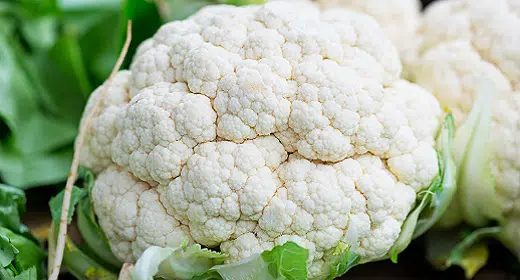by Ocean Robbins: If cauliflower isn’t a smart dietary choice, why does it look like a brain?
OK, so not the most rational argument I’ve ever made on this blog, but I’ll get to the scientific evidence real soon. First, though, I’d like to take a moment to celebrate cauliflower’s moment in the sun.
It used to be thought of as a bland side dish, often overcooked — like broccoli’s awkward mediocre cousin. Now, cauliflower is enjoying a hip makeover as a meat and starch substitute, transforming into cauliflower “wings,” “steaks,” and “rice.”
Notwithstanding its newfound popularity, cauliflower has actually been celebrated in some places for decades. For example, the city of Saint-Omer in France holds an annual Cauliflower Festival in October highlighting cauliflower and other fresh produce in a local market that partially floats on the Aa canal (a location presumably named by some medieval marketing consultant who was like, “Your waterway will be the first one people see in the Yellow Pages!” By the time the villagers thought to ask, “What the heck are the Yellow Pages,” it was too late.).
Cauliflower is winning new fans who are discovering its versatility, mild flavor, and “meatiness.” Its admirers also often use it as a “low-carb,” gluten-free substitute for bread and pasta (though 78% of its calories come from carbohydrates). And riced cauliflower and cauliflower pizza crust are offered in both grocery stores and restaurants.
But aside from its culinary popularity, the health-promoting power of cruciferous vegetables like cauliflower is nothing short of extraordinary. This group of veggies offers a wide variety of health benefits, but is especially noteworthy for its anticancer properties. Let’s take a look at the benefits of eating cauliflower, as well as how you can prepare it at home.
Cauliflower Origins
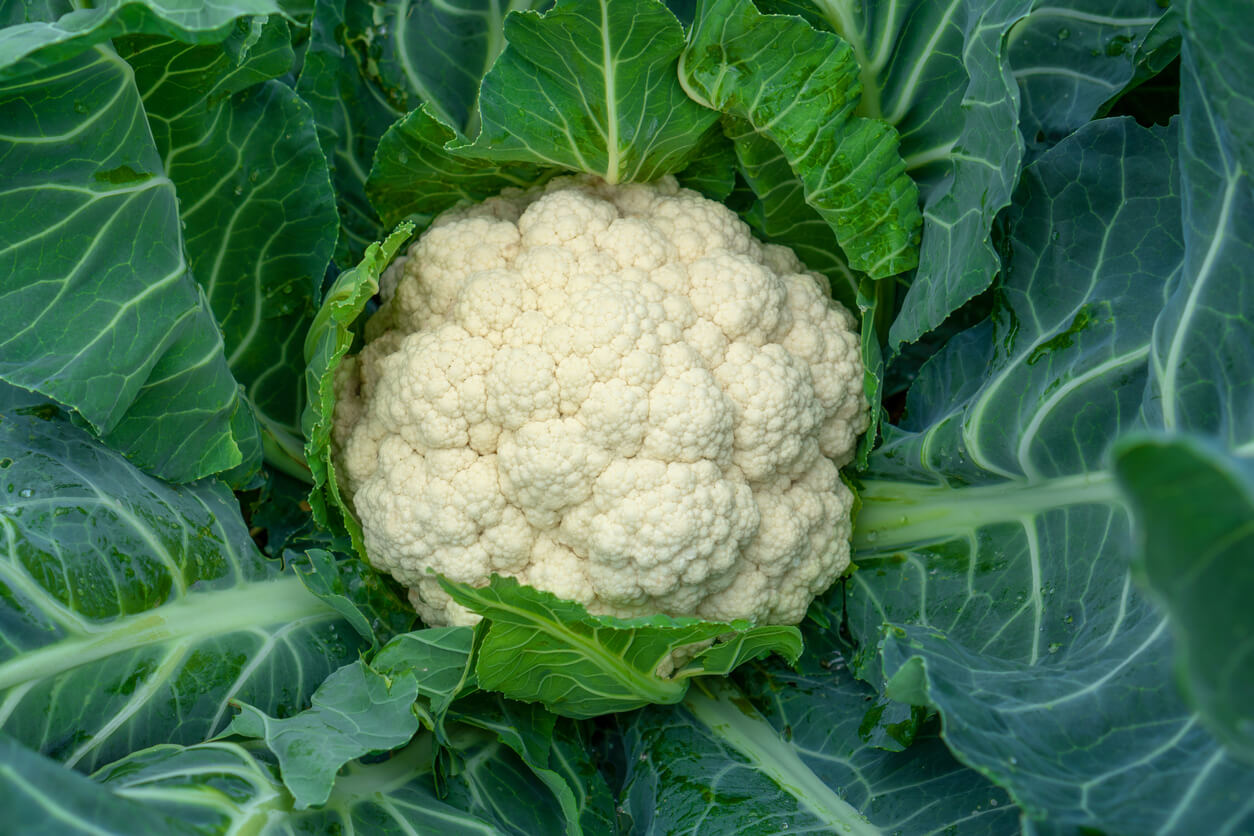
Cauliflower comes from the Latin words caulis, meaning “cabbage,” and flos, meaning “flower.” It’s a descendent of the wild cabbage, Brassica oleracea, and part of the Brassica or cruciferous family of vegetables (which includes Brussels sprouts, broccoli, and cabbage), named for their unique cross-shaped leaves. Like flowers and cabbages, cauliflower comes in different colors, not just the white varieties we see so often.
Domestication of cauliflowers occurred relatively recently. They were apparently introduced into Europe from the Middle East or Cyprus, around the end of the 15th century.
As for reaching the United States, cauliflower didn’t make its debut until the late 1800s or early 1900s. And it has skyrocketed in use and demand since then. Today, California produces more cauliflower than any other state, with much of it growing in the Salinas Valley, also known as the “Salad Bowl of the World.”
Types of Cauliflower
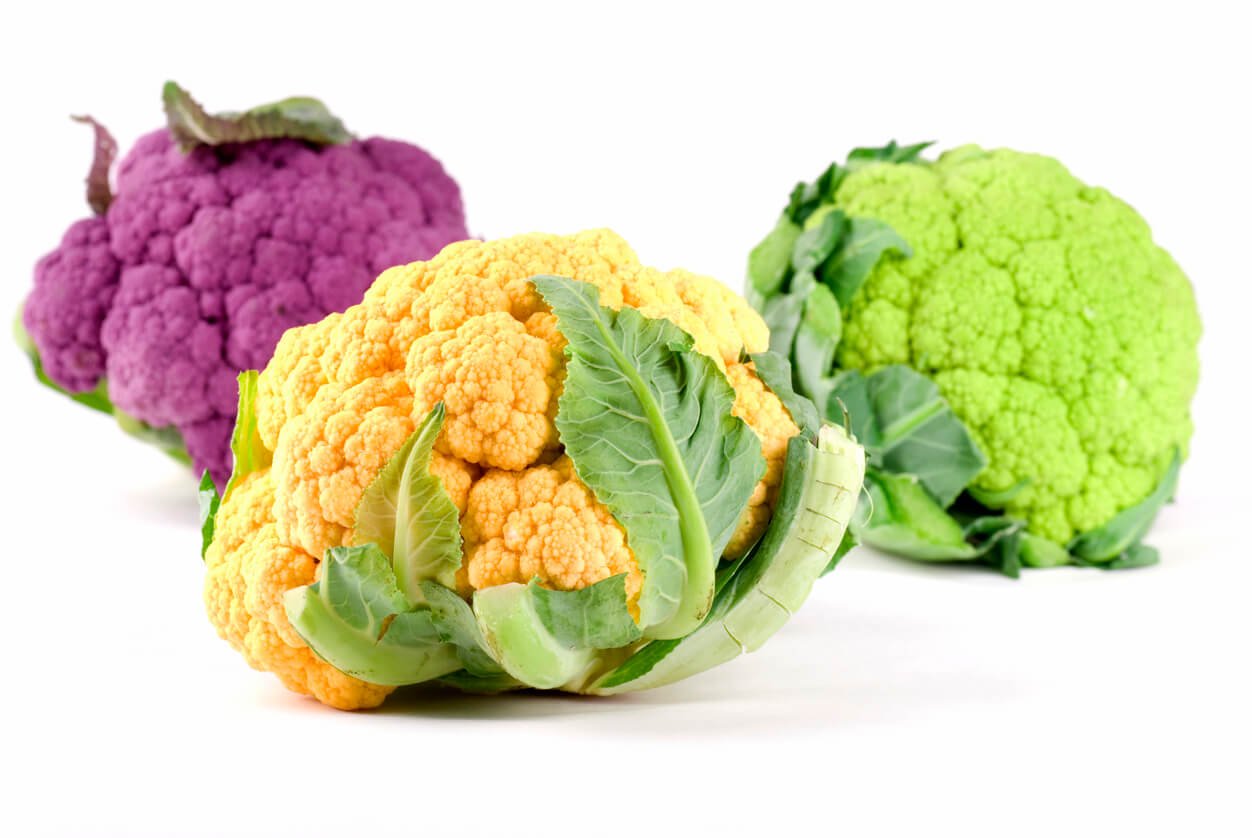
Most cauliflower is white, but it also comes in fun colors, like orange, green, and purple. These varieties can be harder to find, though they are more common at natural and specialty food stores, farmers markets, or CSAs. But they are pretty easy to grow from seed if you want your own supply. If you plant them along the edges of your garden, you can explain to visitors that you’re growing “border caulies.” You’re welcome.
White Cauliflower
The white varieties, like Snowball, White Corona, and Early White, remain pale of hue because they’re completely covered by their leaves as they grow and mature. To help preserve the white coloring, farmers will tie down the largest outer leaves of each cauliflower plant. This protects them from direct sunlight, preventing the development of chlorophyll, the pigment that turns so many vegetables green.
Green Cauliflower
Green cauliflower, also known as broccoflower, is actually a broccoli-cauliflower hybrid plant. The Romanesco variety exhibits a spiral growth pattern and grows to a similar size as white cauliflower. However, it ends up with a crunchier, nuttier flavor. Generally, green cauliflower is sweeter, milder, and more fibrous than white cauliflower. Also, staring at its groovy fractal spirals is a great way to connect to the mysteries of the universe without psychoactive assistance.
Orange Cauliflower
Orange varieties of cauliflower have more beta-carotene pigment — the orange nutrient found in carrots, orange bell peppers, and sweet potatoes. This is a good thing, since orange cauliflower has 25% more vitamin A than its white counterpart. Its color actually resulted from a spontaneous genetic mutation (not to be confused with genetic engineering) in the 1970s — in a cauliflower plant growing in a field north of Toronto. This particular cauliflower head was able to store enough beta-carotene to produce a noticeable orange tint.
Selective breeding has led to the orange cauliflowers we know and love today. Popular orange cauliflower varieties, like Cheddar, Orange Burst, and Orange Bouquet, are sweeter and creamier than other cauliflower varieties. And its peak growing season is fall, aligning well with other similarly colored produce on the shelves around Halloween.
Purple Cauliflower
Lastly, purple cauliflower comes in a range of beautiful hues, from lavender, to violet, to dark purple. These contain more anthocyanins, or antioxidant pigments that give produce like eggplant and blueberries their purple, red, and blue coloring. Some popular varieties of purple cauliflower are Sicilian Violet, Violet Queen, and Purple Cape. These are sweet, mild, and nutty and can be used pretty much anywhere you would use white cauliflower.
Cauliflower Nutrition
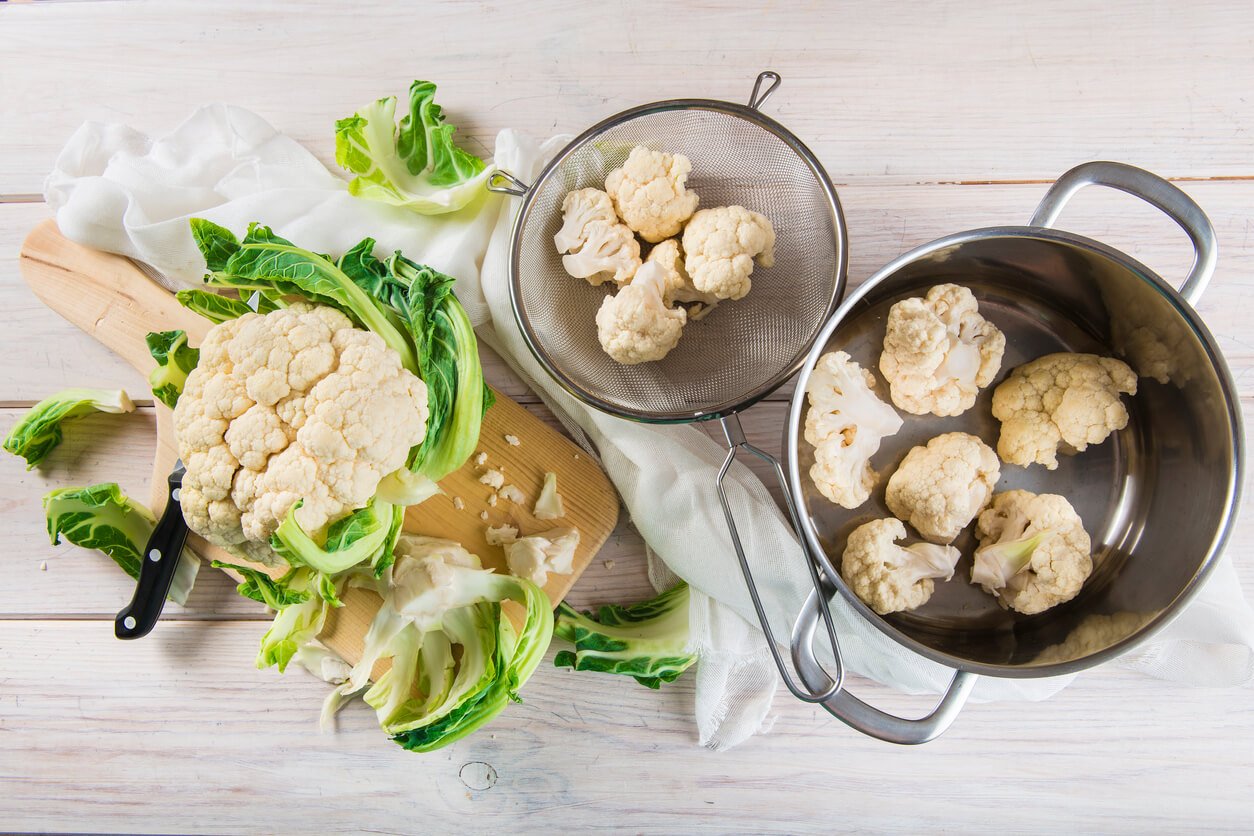
Cauliflower is a nutritional powerhouse, offering an array of vitamins and minerals that are excellent for your health. There are some slight micronutrient differences between raw and cooked cauliflower, which you can see below.
| 100 grams of raw cauliflower offers: | And for comparison, 100 grams of boiled cauliflower offers: |
| 25 calories | 23 calories |
| 2 grams protein | 2 grams protein |
| 5 grams carbs | 4 grams carbs |
| 2 grams fiber | 2 grams fiber |
| 22 mg calcium | 22 mg calcium |
| 15 mg magnesium | 9 mg magnesium |
| 44 mg phosphorus | 32 mg phosphorus |
| 300 mg potassium | 142 mg potassium |
| 30 mg sodium | 15 mg sodium |
| 57 mcg folate | 44 mcg folate |
Boiling cauliflower causes it to lose some of its vitamins and minerals in the cooking water. But steamed cauliflower loses far less. And whether steamed, boiled, or raw, cauliflower is rich in micronutrients like phosphorus, potassium, vitamin C, folate, and vitamin K1, as well as antioxidants. Like most other plant foods, it also contains small amounts of all nine essential amino acids.
While cauliflower is great for you no matter how you prepare it, research shows that you’ll get the most antioxidants ― like polyphenols and flavonoid compounds ― from eating it raw. Extracts from cooked cauliflower showed lower antioxidant activity than uncooked extracts. Steaming is the next best option, followed by boiling.
Cauliflower and the other cruciferous veggies contain an extensively studied set of plant compounds that turn into the powerful cancer-fighting phytonutrient sulforaphane. Specifically, the isothiocyanate compound glucoraphanin interacts with the enzyme myrosinase and converts into sulforaphane.
To activate sulforaphane, you can eat cauliflower raw (chewing does the trick); chop it and let it sit for about 40 minutes before cooking; or combine it, after cooking, with a bit of other raw cruciferous veggies such as grated cabbage or dry mustard powder. Also responsible for the strong smell of cruciferous veggies (nature’s way of warding off pests), sulforaphane is a potent antioxidant with anti-inflammatory, brain-protective, anticancer, and antimicrobial properties.
Cauliflower Health Benefits

Thanks to many of the nutrients and antioxidant compounds it contains, cauliflower offers a number of health benefits that may convince you to enjoy it on a regular basis (if you’re not already an enthusiastic cauliflower eater).
1. May offer antimicrobial benefits.
Like all cruciferous veggies, cauliflower is chock full of compounds studied for their ability to fight off various germs. For instance, a 2015 petri dish study found that cauliflower byproducts were able to slow the growth of, and in some instances even help kill off, harmful germs responsible for foodborne illnesses, such as E.coli and Listeria. The most effective pairing was putting cauliflower up against Salmonella Typhimurium, a common bacteria in eggs.
2. May offer anticancer benefits.
Cruciferous vegetables are one of the best ways to help your body protect itself against diseases like cancer. This is because the Brassica family of veggies is so high in disease-fighting nutrients like fiber, vitamins C, E, K, folate, beta-carotene, lutein, zeaxanthin, and several minerals. They also contain sulfur-containing compounds called glucosinolates, which, as we’ve seen, can convert to sulforaphane.
Other glucosinolates are broken down into compounds called indoles and isothiocyanates. All these compounds have been observed to help inhibit cancer cell growth and spread in lab and animal studies. Researchers think this is because they can help protect cells from DNA damage, offer anti-inflammatory and antimicrobial benefits, kill cancer cells, inactivate carcinogens, and prevent blood vessels from forming in tumors that would otherwise allow them to grow.
While human research is nuanced, there’s strong reason to believe that eating cruciferous veggies is a good idea to help keep your cells healthy.
3. May help with blood clotting and bone strength.
Cauliflower is high in vitamin K1, also called phylloquinone, which is known as the “coagulation” vitamin. Vitamin K1 helps to form essential blood clots where needed. If you don’t get enough vitamin K1, you are more likely to experience hemorrhaging, or excessive bleeding, from a wound. Vitamin K is also good for helping to regulate your calcium balance, and studies show that it helps build strong teeth and bones.
4. May be beneficial for the immune system.
You’ll find a good amount of vitamin C in cauliflower. Vitamin C is an antioxidant that’s known to support a healthy immune response. And it’s important to get enough vitamin C from foods like cauliflower because humans can’t make it ourselves. One cup of raw, chopped cauliflower florets will give you about 52 mg of vitamin C, which is more than two-thirds of the recommended dietary allowance for adults.
5. May help protect against kidney disease.
A 2021 study examined how sulforaphane in cruciferous veggies like cauliflower may actually help fight off oxidative damage in kidney disease. Apparently, it does this by activating what’s called the Nrf2 pathway in the body (no, it has nothing to do with “Nerf” foam footballs). This pathway is responsible for helping the body make its own antioxidants “in-house” that can then be directed to fight off damaging reactive oxygen species where needed.
Concerns & Downsides to Cauliflower

Despite all of its benefits, cauliflower may have a few potential downsides to consider for some people.
Digestive Discomfort
First, cauliflower may trigger gas and other digestive complaints if you’re not used to eating it. This is largely because it contains raffinose, a type of oligosaccharide that doesn’t digest completely, and that ferments in the large intestine. For a small number of people, raffinose can cause gas, abdominal bloating and pain, constipation, or diarrhea. It can also cause further irritation in people with existing gastrointestinal disorders like irritable bowel syndrome or irritable bowel diseases.
But raffinose and other oligosaccharides aren’t all bad. They’re actually a type of prebiotic fiber, which helps to feed good gut bacteria in your digestive tract. If you’re new to cauliflower, you may need to start off by eating small quantities to allow your gut microbiome to acclimate.
Allergies
While very rare, some people may have an allergy to cauliflower. There have been cases of anaphylaxis allergic reactions to eating it. This may be concurrent with having oral allergy syndrome, where compounds in cauliflower cross-react with a type of pollen in the air and cause a reaction in some people. A salicylate allergy can also be problematic when it comes to cauliflower, as it contains this potential allergen.
Goitrogens
Lastly, cauliflower contains compounds called goitrogens, which can interfere with iodine uptake and thyroid hormone production. However, as long as you’re getting adequate iodine and selenium, this is unlikely to be a problem. If you’re concerned about it, you can cook cauliflower to help reduce the amount of goitrogens it contains.
But my advice, for most people, is not to avoid cauliflower because of goitrogens. Instead, eat cauliflower along with a wide variety of other foods as part of a healthy, balanced diet. Cauliflower is full of plant compounds, vitamins, and minerals that offer benefits that, for most people, vastly outweigh any potential risks.
Is Cauliflower Sustainable?
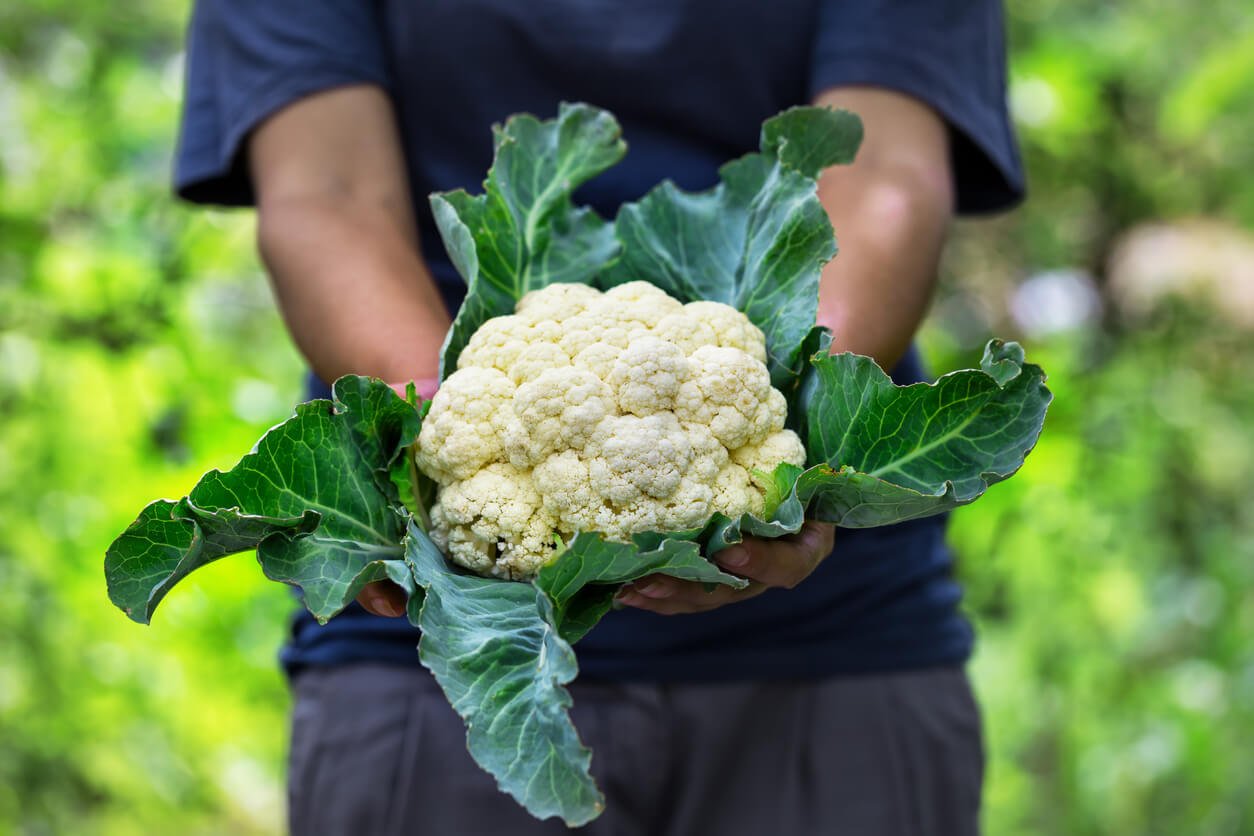
Cauliflower offers undeniable nutritional and health benefits to consumers. But what about its environmental impacts?
The Environmental Working Group (EWG), which tests an array of produce every year to determine how contaminated they are, has put cauliflower on the Clean 15 list. This means it’s among the types of produce least likely to have contamination from agricultural chemicals like pesticides. And according to the USDA’s Pesticide Data Program, half of the cauliflower samples tested in 2012 didn’t show any pesticide residue at all.
But that doesn’t mean cauliflower is totally pesticide-free. There are still a number of pesticides used on this crop, some of which are harmful to important pollinators like honeybees. Buying organic isn’t as important with cauliflower as it is with berries, spinach, apples, and other foods that have higher levels of pesticide contamination, but it’s still best for human and environmental health.
As for its global warming impact, one 2019 study out of the United Kingdom found that cauliflower was among a few vegetables with a low impact, based on factors such as farming practices, storage, packing, and transportation.
But as mentioned earlier, the majority of US-based cauliflower — around 90% — is produced in California. Unfortunately, this area is drought-prone, and growing cauliflower, or any type of produce for export, essentially means that California is exporting water. Try to buy locally-grown cauliflower whenever you can; it’s a common crop available at farmers markets, through community-supported agriculture (CSA) programs, or even U-pick farms where you can harvest your own produce right from the field.
Of course, you can always grow your own cauliflower. Plant seeds and starts early in the growing season, and tell your visitors that you’re giving them a “head start.” You’re welcome (again)!
Growing Cauliflower
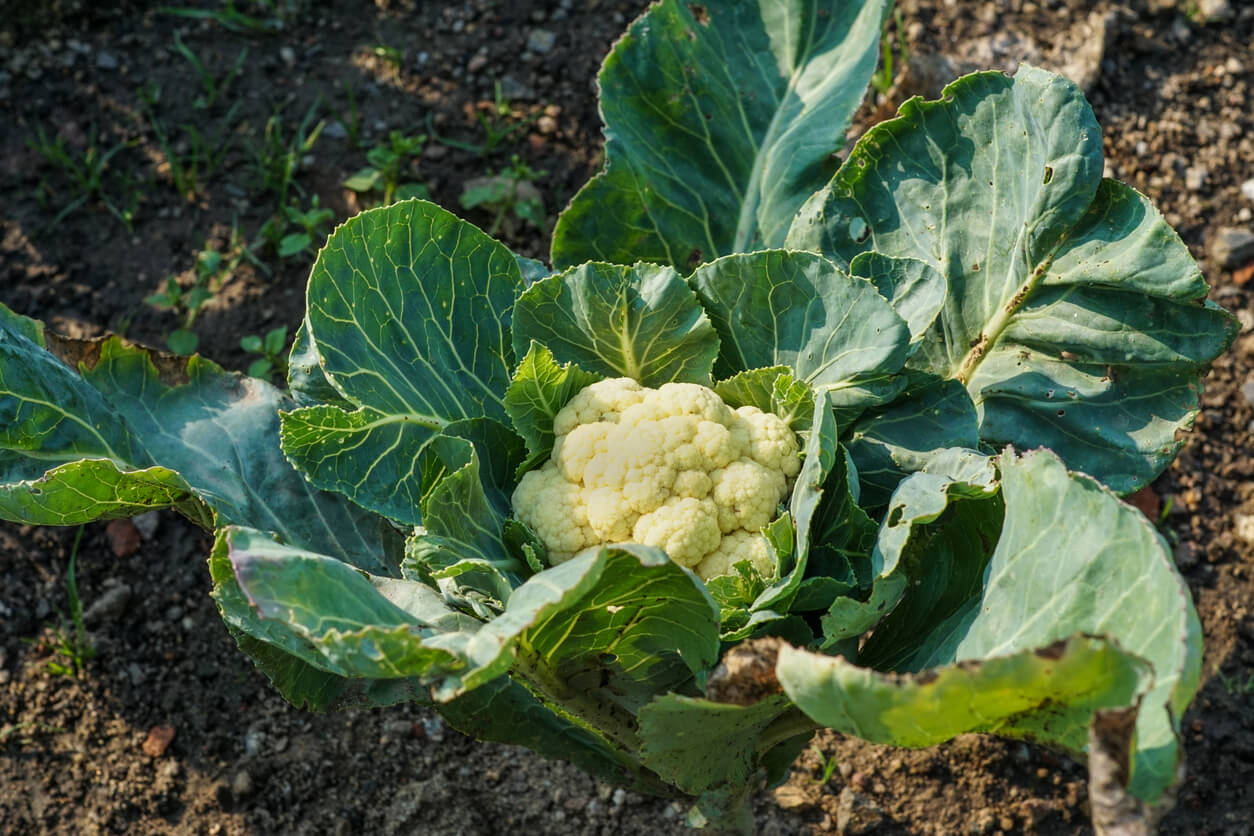
If you’re going to grow cauliflower, just know they can be a bit tricky to grow. For reference, cauliflower is considered a “half-hardy” biennial that can grow in zones 2-11. This means it can withstand some frost, but does best with a combination of full sun plus consistently cool temperatures in the 60°F range. In warmer climates, plant cauliflower in the fall for an early spring crop. But in more extreme temperature zones, you may want to plant cauliflower indoors in the early spring, or outdoors in the late summer, to avoid peak heat and cold.
Also, to get the head of your cauliflower white, you’ll need to engage in a practice known as blanching. This means that when the white head — also called the curd — is between two and three inches in diameter, you tie the outer leaves together over the head and secure it with something (like a rubber band, tape, or twine) to keep the sunlight out. For other color varieties, like purple and orange, blanching is not necessary. There are also some self-blanching types of cauliflower that will take care of this process themselves.
How to Choose & Store Cauliflower

For the best cauliflower, try to get it when it’s in season. This is typically during the summer and into the early fall, but cauliflower may also still be going strong into the winter in some areas. If you’re in the United States, check out this seasonal produce guide to find out when cauliflower is a peak crop for your location.
When you’re choosing cauliflower to take home, there are a few things to keep in mind. First, fresh cauliflower should have tight, compact curds and bright green, intact leaves. Avoid plants that have brown, slimy spots, or loose sections, as this indicates damage and potential rotting, as well as a shortened lifespan.
Proper storage helps ensure that your cauliflower will stay fresh for as long as possible. When you get it home, store your cauliflower in a produce bag in the crisper drawer, where it should last for about a week before it starts to show brown spots. Before you prepare your cauliflower to eat, remove its outer leaves, cut it into florets, and wash thoroughly.
You can also cut the cauliflower into florets when you get it home and store these in an airtight container in the refrigerator or freezer. If you choose the latter, it’s best to blanch your florets before freezing to retain the most nutrients. Fresh cauliflower is also delicious when pickled or fermented, which also preserves it longer.
Cauliflower Products
You’ve probably noticed the growing variety of cauliflower products available outside of the produce section. The snack aisle has seen a huge expansion in its cauliflower-based offerings, especially as gluten-free and grain-free alternatives to common wheat-based products. You can find cauliflower crackers and puffs, sandwich thins to use as a bread alternative, tortillas and veggie chips, pre-made and grain-free pizza dough, frozen cauliflower rice, and cauliflower-based pastas.
While many people enjoy trying cauliflower-based grain alternatives for the flavor and variety, these products are also a welcome option for those who need to avoid gluten for medical reasons. For instance, individuals with Celiac disease can enjoy the versatility of cauliflower products in place of traditionally gluten-based ones.
But for most people, the major benefits from cauliflower will come from enjoying it in its natural, unprocessed form.
How to Cook & Prepare Cauliflower

Cauliflower works well as an appetizer, a main entree, or a side dish. Its relatively neutral flavor allows plenty of opportunities for experimentation in the kitchen.
As a starter, use cauliflower to make dips, veggie tots, or breaded cauliflower floret “wings.” As a side dish, it works well cooked and made into a rice or mash, or simply tossed with a sauce or flavorful spices. And as a main dish, cauliflower lends itself well to a stir-fry, used in pizza crust or as a pizza topping, in pasta dishes and curries, blended into creamy soups, or sliced and made into cauliflower “steaks.”
The best cooking method depends on how you want to use your cauliflower. You can eat it raw, chopped into florets with a dip like hummus, or as a raw cauliflower rice base for “grain” salads. You can also enjoy cauliflower cooked in a number of ways, like boiled, stir-fried, air-fried, baked, roasted, steamed, grilled, or microwaved. If you’re looking to keep most of the water-soluble nutrients, like vitamin C, intact in your cauliflower, avoid cooking methods that use water. Instead, try baking or roasting it.
Cauliflower Recipes
Wow your party guests or family members with an out-of-this-world appetizer that offers a taste bud and sensory explosion. Buffalo Cauliflower with Tofu Ranch blends spicy, cool, crispy, and creamy, creating an exquisite and tantalizing experience. Swap rice for cauliflower in the Cauliflower “Fried” Rice. This dish is packed with a variety of veggies as well as pineapple for a colorful sweet and savory side. The Cauliflower “Steak” with Peanut Sauce is the type of steak that leaves you feeling energized and healthy. Can’t choose which to make? Capture all of cauliflower’s versatility by trying all three!
1. Buffalo Cauliflower with Tofu Ranch

Cauliflower becomes the star of the party when made into a fun, finger-food appetizer. Healthy cauliflower tastes like an indulgent splurge, but with its high fiber, vitamin C, and phytonutrient content, it’s anything but! Pair the spicy crucifer with cooling Tofu Ranch Dressing for a tastebud and sensory explosion that your guests will rave about!
2. Cauliflower “Fried” Rice

With a cruciferous base like cauliflower, plus more plant goodness from onions, broccoli, carrots, peas, corn, and pineapple, you can’t go wrong with this nourishing and tasty side dish. It provides an abundance of fiber and phytonutrients, not to mention lots of texture and flavor. Make it a complete meal by adding some organic tofu or edamame and bean sprouts.
3. Cauliflower “Steak” with Peanut Sauce

This “steak” won’t leave you feeling like your body’s working overtime to digest it. Instead, it delivers satisfying texture and flavor along with nutrients — such as vitamin C, phytonutrients, and fiber — that your body needs to function at its best (and nutrients that you can’t get from traditional steak!). Add protein-rich peanut sauce and prebiotic-rich toppings, and you have yourself a near-perfect meal!
Enjoy Cauliflower
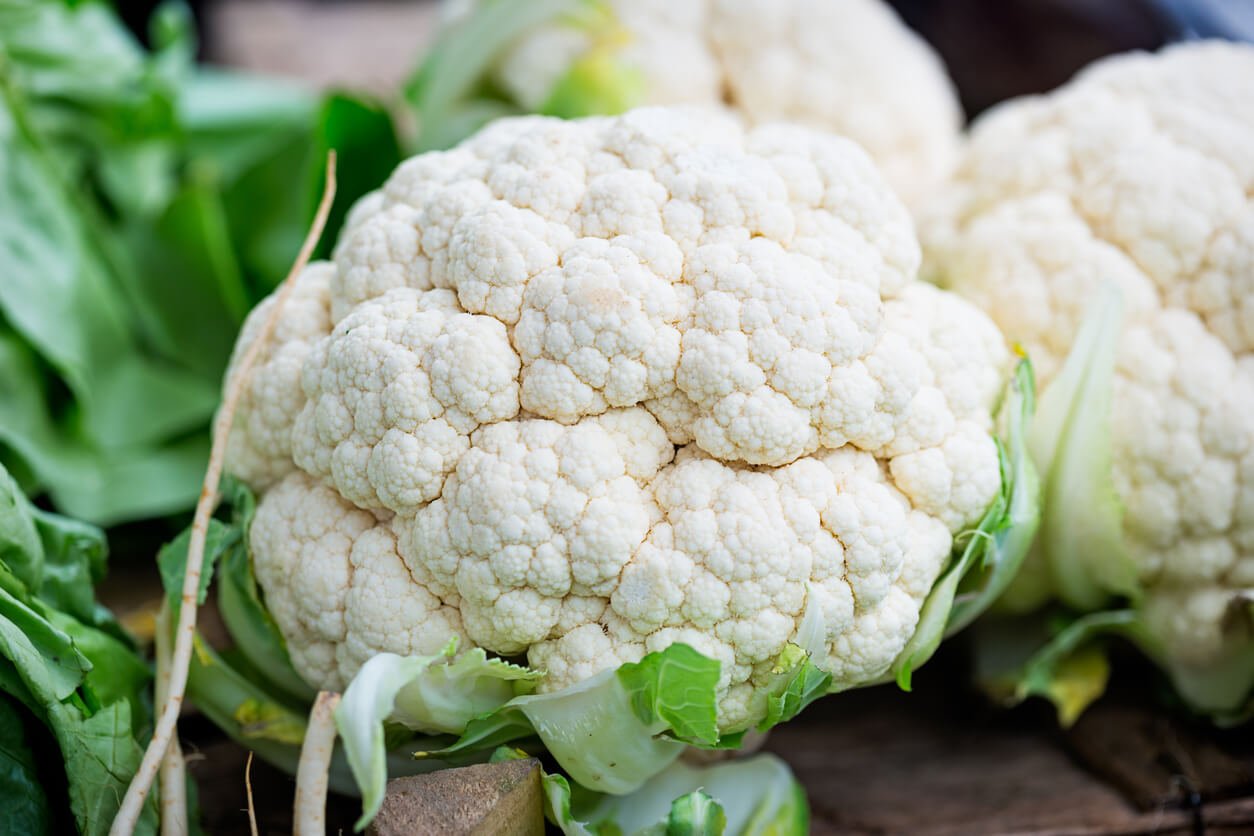
Cauliflower, and cauliflower products, are immensely popular for their versatility and nutritional value. This cruciferous veggie offers a number of health benefits, especially from antioxidant compounds like sulforaphane. Although there are a few small considerations when eating cauliflower, for the majority of people, the effect on your health is likely to be wholly positive. We recommend including whole, unprocessed cauliflower as part of a healthy balanced diet.







